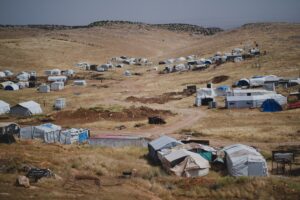JULY 30TH, 2022 WORLD DAY AGAINST TRAFFICKING IN PERSONS STATEMENT ON THE NEED FOR
UNIVERSAL STANDARDARIZED INDICATORS OF HUMAN TRAFFICKING
The World Day against Trafficking in Persons was proclaimed by the United Nations General Assembly in a resolution in 2013 that is observed on July 30 every year. Human trafficking is the second largest criminal enterprise in the world, and there are approximately 40 million people around the world who are trapped in this form of modern slavery[1]. Most countries have national human trafficking laws, but with recent increases in armed conflicts around the world and cross-border migration, there is also a need for enhanced collaboration and consensus on indicators of human trafficking across nations. The UN Palermo Protocol[2] was helpful in providing a universal definition for trafficking in human beings, and we believe it would be similarly helpful to have universally adopted standardized indicators of human trafficking. Traffickers operate with advanced criminal networks, and survivors of trafficking should have advanced networks of identification and care.
Armed Conflict Increases the Risk of Human Trafficking[3]
Armed conflict between countries poses a high risk of human trafficking within conflict-affected countries. Currently, there are 27 armed conflicts around the world[4]. “For predators and human traffickers, the war in Ukraine is not a tragedy. It’s an opportunity – and women and children are the targets,” stated UN Secretary General Guterres[5]. Human trafficking is exacerbated by every other crisis in the world. Traffickers frequently promise stability and hope for displaced individuals.
The vulnerability to trafficking arises from armed conflict through interruptions in the provision of essential services such as health care and education, a lack of income generating opportunities, and the risk of exploitation within armed combat itself.[6] Prior to the crisis in Ukraine and Afghanistan, more than 280 million migrants[7] were among the individuals most vulnerable to human trafficking, and the global migration crisis has increased the human trafficking crisis. Those forced to leave their homes, a record 80 million in 2020[8], are at particular risk.
Necessity of Harmonized Indicators of Human Trafficking
In light of the increase in armed conflicts and mass migration globally, it is important to prioritize the adoption of universally standardized indicators of human trafficking as a precursor to an eventual Transnational Referral Mechanism throughout Europe and other regions. A Transnational Referral Mechanism (TRM) is defined by the OSCE as “the concept of a co-operative agreement for the cross-border comprehensive assistance and/or transfer of identified or potential trafficked persons, through which state actors of different countries fulfill their obligations to promote and protect the human rights of trafficked persons.”
We, therefore, recommend universally adopted standardized indicators of human trafficking. A universal standardized framework such as this is especially important with the increase in cross-border migration and movement. Such universal indicators will allow for proactive identification of victims of human trafficking, increased connection to services for individuals, and ultimately increase the prosecution rate of traffickers. Because of this we urge countries to adopt such a harmonized framework either legislatively or procedurally, in order to ensure the possibility for early detection of victims of human trafficking and provide them with safe networks of care, regardless of where their exploitation takes place.
*This statement was prepared by the Task Force on Human Trafficking for the Parliamentary Intelligence Security Forum in coordination with eLiberare anti-trafficking organization.
[1] https://www.ilo.org/global/topics/forced-labour/lang–en/index.htm#:~:text=Facts%20and%20figures,15.4%20million%20in%20forced%20marriage
[2] https://www.ohchr.org/en/instruments-mechanisms/instruments/protocol-prevent-suppress-and-punish-trafficking-persons
[3]Conflict_Ukraine_TIP_2022.pdf https://reliefweb.int/sites/reliefweb.int/files/resources/Conflict_Ukraine_TIP_2022.pdf
[4] https://www.cfr.org/global-conflict-tracker
[5] United Nations News: Ukraine ‘we need peace now’ declares Guterres, warning of global hunger meltdown. https://news.un.org/en/story/2022/03/1113882
[6] UNODC (2018). Trafficking in Persons in the Context of Armed Conflict: www.unodc.org/documents/data-andanalysis/glotip/2018/GloTIP2018_BOOKLET_2_Conflict.pdf; UNODC (2018). Countering Trafficking in Persons in Conflict Situations: Thematic Paper www.unodc.org/documents/humantrafficking/2018/1708776_ebookCountering_Trafficking_in Persons_in_Conflict_Situations.pdf.
[7] World Economic Forum: World Day against Trafficking: Challenging misconceptions about it in migration pathways. https://www.weforum.org/agenda/2021/07/world-day-against-trafficking-challenging-misconceptions-about-human-trafficking-in-migration-pathways/
[8] UNHCR, The UN Refugee Agency: Forced displacement passes 80 million by mid-2020 as Covid-19 tests refugee protection globally. https://www.unhcr.org/news/press/2020/12/5fcf94a04/forced-displacement-passes-80-million-mid-2020-covid-19-tests-refugee-protection.html

